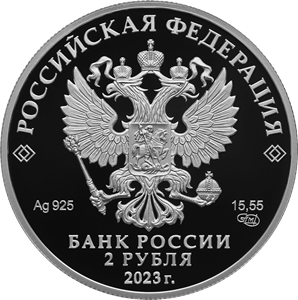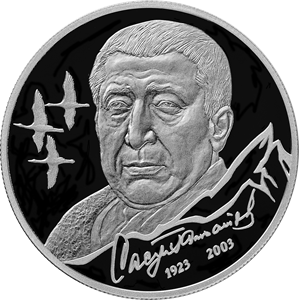Poet Rasul Gamzatov, the 100th Anniversary of his Birth
Obverse
a relief image of the National Coat of Arms of the Russian Federation and a semicircular inscription above it along the rim: ‘РОССИЙСКАЯ ФЕДЕРАЦИЯ’ (RUSSIAN FEDERATION) framed with paired diamonds on both sides, under the coat of arms there are the chemical symbol of the metal and fineness on the left and fine metal content and the mint trade mark on the right, at the bottom in the centre, in three lines, there is an inscription: ‘БАНК РОССИИ’ (BANK OF RUSSIA), the coin denomination: ‘2 РУБЛЯ’ (2 RUBLES), and the year of issue: ‘2023 г.’ (2023).
Reverse
relief images of Rasul Gamzatov’s portrait and flying cranes, as well as the facsimile of the poet’s signature, and the years of his birth and death ‘1923’ and ‘2003’ inside a stylised outline of a mountain peak.
Authors
Designers: E.V. Kramskaya (obverse), A.A. Chernova (reverse).
Sculptors: A.A. Dolgopolova (obverse), A.A. Chernova (reverse).
Mint: Saint Petersburg Mint (СПМД).
Edge: 195 corrugations.
Discover more
Rasul Gamzatov (1923–2003) is a poet, opinion journalist, and public figure.
He started writing verses when he was a child. His first tutor in the art of poetry was his father Gamzat Tsadasa, a poet and translator. During the Great Patriotic War, Gamzatov published his verses in the Bolshevik Gor newspaper. His lyrics were devoted to soldiers’ deeds of arms. He also wrote sketches and articles about war heroes from Daghestan. He wrote his first verses under the surname of his father and, later on, adopted the pen name Gamzatov derived from his father’s name.
Gamzatov’s first book of verses was published in 1943 when he was just 20 years old. The book was published in his native Avar language, spoken by the Avars, a Caucasian ethnic group. The book Love Inspired and Fiery Wrath included verses about the war. The book My Homeland published in Daghestan in 1948 was the first collection of his verses in Russian. Gamzatov’s book Songs of Mountains was issued by the publishing house Molodaya Gvardiya in Moscow a year later, in 1949. The young author’s verses were praised by literary persons. Newspapers and magazines published his lyrics from the book.
In 1951, Rasul Gamzatov became the chairman of the Union of Daghestan Writers and chaired it until his death. He was engaged in public work helping literary persons issue their books, guiding young authors and communicating with publishers and newspaper editors.
In 1958, Gamzatov published his poem Mountain Girl raising important topics of mountain peoples’ traditions and attitude towards women. The poem was reprinted several times and translated into foreign languages. The storyline became the basis for Gamzatov’s play with the same name staged by the country’s theatres. It also inspired a movie produced in 1975.
After the 1960s, Gamzatov started writing epigrams and epistles which were new genres for the author. Large Soviet publishing houses and leading literary magazines printed Gamzatov’s works. Critics and literary persons admired his works for the humour and meaningfulness.
In 1967, Gamzatov released his lyrical story My Daghestan describing his homeland and its residents and talking about life, literature, culture, poetry, and creative work. This was Gamzatov’s first prose work, but it also contained verses.
The poet wrote in his native Avar language. His works were translated into Russian by Naum Grebnev, Ilya Selvinsky, Yakov Kozlovsky and other writers. Rasul Gamzatov translated verses and poems by Aleksandr Pushkin and other Russian poets, including Mikhail Lermontov, Nikolay Nekrasov and Vladimir Mayakovsky, into the Avar language.
Many verses by Gamzatov were put to music. At first, these songs were performed in Daghestan and, in the 1960s, they became popular in the entire Soviet Union. Soviet composer Yan Frenkel put Rasul Gamzatov’s verse Cranes to music, and the song was then performed by singer and actor Mark Bernes. It was played on the radio and TV, the image of cranes symbolising dead soldiers was immortalised in monuments, people from all over the country and the world sent letters of gratitude to the author. The song became a symbol of tribute to soldiers who died during the Great Patriotic War.
Gamzatov regularly published his journalistic articles in newspapers and magazines talking of history, society’s problems, literature, and culture.
Source: https://www.culture.ru


